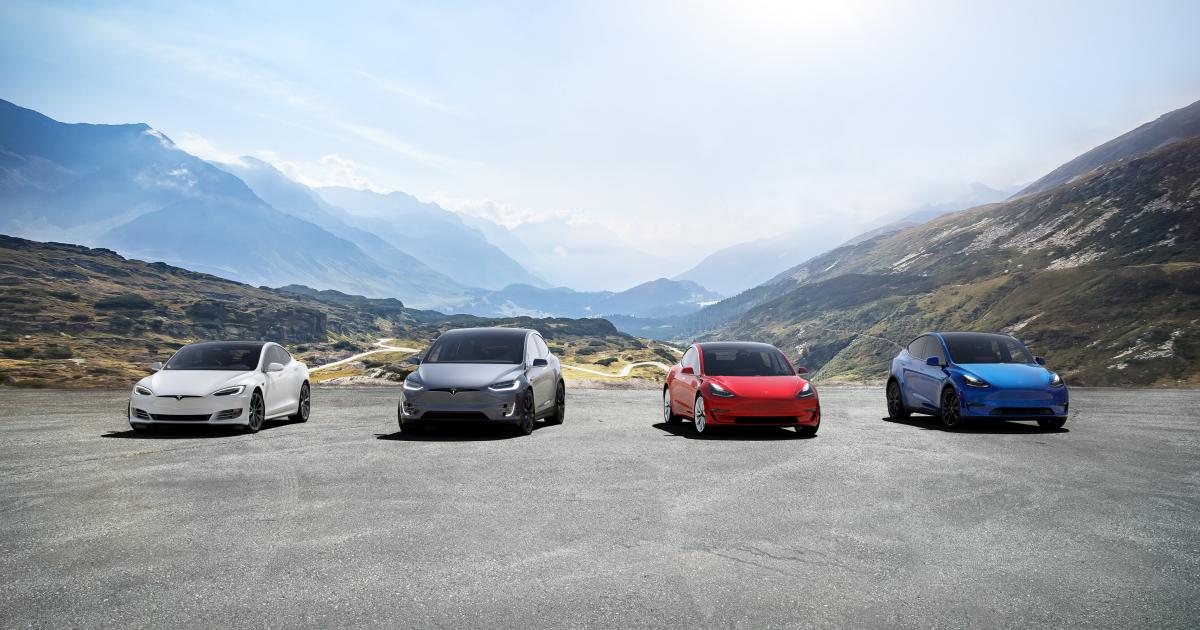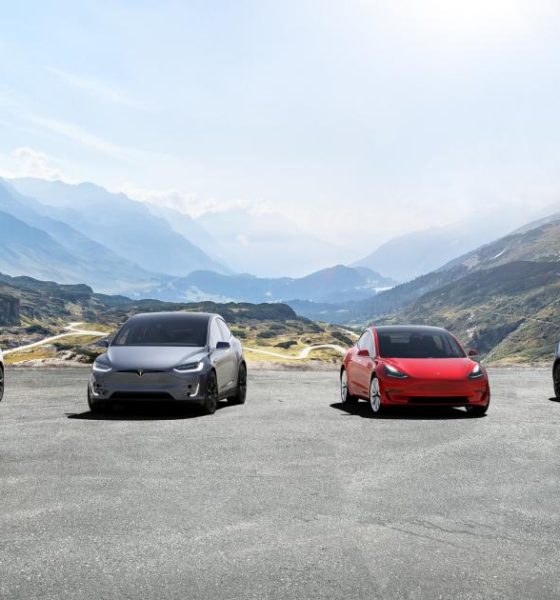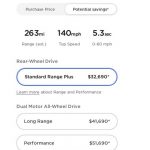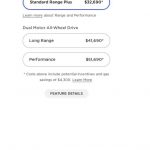All four of Tesla’s vehicles have been given revised delivery dates over the past few days as Q1 2021 comes to the end. Demand seems to be the real indicator of why Tesla has revised the price target for some of the cars, while a recent update from CEO Elon Musk points to delays for the other vehicles.
Tesla Model 3
The Model 3 has undergone several revisions in its delivery timeframe recently. After being revised from 2-4 weeks to “June,” the Model 3 now displays a timeframe of 2-14 weeks, giving an indication that demand is through the roof for the all-electric sedan. Tesla’s most popular vehicle could be experiencing higher demand for some variants and less for others, which is why the time frame is so broad.
Tesla Model Y
The Model Y also has been the subject of several delivery timeframe modifications. After starting at 2-5 weeks for delivery yesterday, this was revised to 7-11 weeks. Now, the timeframe sits at 2-11 weeks, also indicating that demand is spiking. Some variants could be in less demand than others, which is the same story as the Model 3. Less frequently purchased configurations of the car could be delivered in two weeks, with more popular powertrains being pushed further back to the 11-week mark, depending on location.
Tesla files to expand Fremont factory, make Model Y ‘tent’ permanent
Model S and Model X
Both the Model S and Model X were supposed to begin deliveries in February and March, according to Musk during the Q4 2020 Earnings Call. Musk said:
“We’re super excited to announce the new Model S and Model X Plaid — are in production now and will be delivered in February. So we’ve been able to bring forward the new Model S and X. And Model S will be delivered in February and Model X a little later.”
However, these releases have been delayed. Despite the Fremont Factory displaying a pack of Model S units that appear to be ready for delivery, Musk indicated that there are still some details to sort out before shipping begins. It could have to deal with manufacturing, but Tesla has also sent Model S Plaid builds to wintery weather areas, like Toldeo, Ohio, for crash testing and all-weather performance assessments.
Still many fine details to address, but the final product will be fantastic. There’s nothing else even close.
— Elon Musk (@elonmusk) March 8, 2021
Currently, the Model S sits at 10-14 weeks, while the Model X has been pushed back to “May-June,” Tesla’s Design Studio says.
Tesla’s End of Quarter pushes usually result in positive marks for the automaker. While demand during the final month of a quarter seems to go up based on previous occasions, Tesla is currently performing a balancing act between making the Model Y line permanent, refining Plaid builds of the Model S and X and continuing the production of the Model 3 after a short stoppage in production at Fremont due to a parts shortage. Regardless, Tesla is primed for a strong start to 2021, especially after new figures from China show demand is healthy.

News
Tesla starts showing how FSD will change lives in Europe
Local officials tested the system on narrow country roads and were impressed by FSD’s smooth, human-like driving, with some calling the service a game-changer for everyday life in areas that are far from urban centers.

Tesla has launched Europe’s first public shuttle service using Full Self-Driving (Supervised) in the rural Eifelkreis Bitburg-Prüm region of Germany, demonstrating how the technology can restore independence and mobility for people who struggle with limited transport options.
Local officials tested the system on narrow country roads and were impressed by FSD’s smooth, human-like driving, with some calling the service a game-changer for everyday life in areas that are far from urban centers.
Officials see real impact on rural residents
Arzfeld Mayor Johannes Kuhl and District Administrator Andreas Kruppert personally tested the Tesla shuttle service. This allowed them to see just how well FSD navigated winding lanes and rural roads confidently. Kruppert said, “Autonomous driving sounds like science fiction to many, but we simply see here that it works totally well in rural regions too.” Kuhl, for his part, also noted that FSD “feels like a very experienced driver.”
The pilot complements the area’s “Citizen Bus” program, which provides on-demand rides for elderly residents who can no longer drive themselves. Tesla Europe shared a video of a demonstration of the service, highlighting how FSD gives people their freedom back, even in places where public transport is not as prevalent.
What the Ministry for Economic Affairs and Transport says
Rhineland-Palatinate’s Minister Daniela Schmitt supported the project, praising the collaboration that made this “first of its kind in Europe” possible. As per the ministry, the rural rollout for the service shows FSD’s potential beyond major cities, and it delivers tangible benefits like grocery runs, doctor visits, and social connections for isolated residents.
“Reliable and flexible mobility is especially vital in rural areas. With the launch of a shuttle service using self-driving vehicles (FSD supervised) by Tesla in the Eifelkreis Bitburg-Prüm, an innovative pilot project is now getting underway that complements local community bus services. It is the first project of its kind in Europe.
“The result is a real gain for rural mobility: greater accessibility, more flexibility and tangible benefits for everyday life. A strong signal for innovation, cooperation and future-oriented mobility beyond urban centers,” the ministry wrote in a LinkedIn post.
News
Tesla China quietly posts Robotaxi-related job listing
Tesla China is currently seeking a Low Voltage Electrical Engineer to work on circuit board design for the company’s autonomous vehicles.

Tesla has posted a new job listing in Shanghai explicitly tied to its Robotaxi program, fueling speculation that the company is preparing to launch its dedicated autonomous ride-hailing service in China.
As noted in the listing, Tesla China is currently seeking a Low Voltage Electrical Engineer to work on circuit board design for the company’s autonomous vehicles.
Robotaxi-specific role
The listing, which was shared on social media platform X by industry watcher @tslaming, suggested that Tesla China is looking to fill the role urgently. The job listing itself specifically mentions that the person hired for the role will be working on the Low Voltage Hardware team, which would design the circuit boards that would serve as the nervous system of the Robotaxi.
Key tasks for the role, as indicated in the job listing, include collaboration with PCB layout, firmware, mechanical, program management, and validation teams, among other responsibilities. The role is based in Shanghai.
China Robotaxi launch
China represents a massive potential market for robotaxis, with its dense urban centers and supportive policies in select cities. Tesla has limited permission to roll out FSD in the country, though despite this, its vehicles have been hailed as among the best in the market when it comes to autonomous features. So far, at least, it appears that China supports Tesla’s FSD and Robotaxi rollout.
This was hinted at in November, when Tesla brought the Cybercab to the 8th China International Import Expo (CIIE) in Shanghai, marking the first time that the autonomous two-seater was brought to the Asia-Pacific region. The vehicle, despite not having a release date in China, received a significant amount of interest among the event’s attendees.
Elon Musk
Elon Musk and Tesla AI Director share insights after empty driver seat Robotaxi rides
The executives’ unoccupied tests hint at the rapid progress of Tesla’s unsupervised Robotaxi efforts.

Tesla CEO Elon Musk and AI Director Ashok Elluswamy celebrated Christmas Eve by sharing personal experiences with Robotaxi vehicles that had no safety monitor or occupant in the driver’s seat. Musk described the system’s “perfect driving” around Austin, while Elluswamy posted video from the back seat, calling it “an amazing experience.”
The executives’ unoccupied tests hint at the rapid progress of Tesla’s unsupervised Robotaxi efforts.
Elon and Ashok’s firsthand Robotaxi insights
Prior to Musk and the Tesla AI Director’s posts, sightings of unmanned Teslas navigating public roads were widely shared on social media. One such vehicle was spotted in Austin, Texas, which Elon Musk acknowleged by stating that “Testing is underway with no occupants in the car.”
Based on his Christmas Eve post, Musk seemed to have tested an unmanned Tesla himself. “A Tesla with no safety monitor in the car and me sitting in the passenger seat took me all around Austin on Sunday with perfect driving,” Musk wrote in his post.
Elluswamy responded with a 2-minute video showing himself in the rear of an unmanned Tesla. The video featured the vehicle’s empty front seats, as well as its smooth handling through real-world traffic. He captioned his video with the words, “It’s an amazing experience!”
Towards Unsupervised operations
During an xAI Hackathon earlier this month, Elon Musk mentioned that Tesla owed be removing Safety Monitors from its Robotaxis in Austin in just three weeks. “Unsupervised is pretty much solved at this point. So there will be Tesla Robotaxis operating in Austin with no one in them. Not even anyone in the passenger seat in about three weeks,” he said. Musk echoed similar estimates at the 2025 Annual Shareholder Meeting and the Q3 2025 earnings call.
Considering the insights that were posted Musk and Elluswamy, it does appear that Tesla is working hard towards operating its Robotaxis with no safety monitors. This is quite impressive considering that the service was launched just earlier this year.















